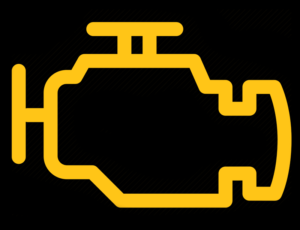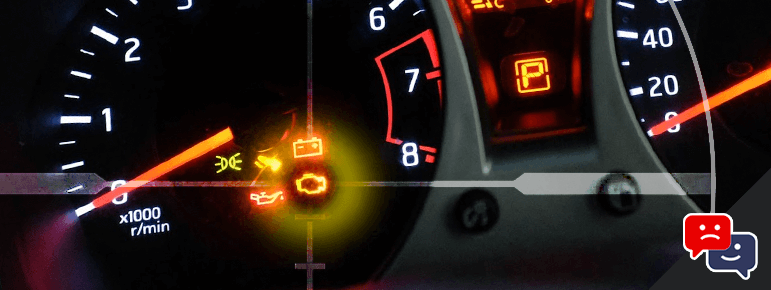If you are a Nissan car owner, then you’ve probably seen the dreaded Check Engine light pop-up on your dashboard. But what causes the check engine light to come on? And is the car safe to drive?
The Nissan Check Engine light illuminates when the car’s computer detects a problem. This light will either stay on or blink. A check engine light that stays on indicates a minor problem, such as a loose gas cap. Blinking light indicates a serious problem, like a bad O2 sensor.
While this warning light can be an alarming sight, it’s your car’s way of telling you something is wrong.
The first step is determine how serious the problem is.
For example, if the check engine light stays on and remains on while you drive, then most likely the problem isn’t serious. And you can continue to drive as normal.
However, take precautions and avoid hard acceleration or exceeding 45mph.
But if the check engine light is blinking and continues to blink as you drive, it’s an indication of a serious mechanical issue. It’s advised to pull off to a safe location and turn the car off. Then call your nearest Nissan service center for help.
Regardless, a check engine light is a sign that you should get the vehicle diagnosed and fixed as soon as possible. Just be aware, a flashing check engine light is more serious, and you should have your car looked at immediately.
Truth is, a check engine light that suddenly pop-ups is an unsettling feeling. The good news is, there are ways to quickly identify how serious the problem may be.
As a car owner, chances are you’ll eventually find yourself dealing with the dreaded check engine light. Truthfully, it doesn’t matter if you drive a Nissan, Buick, GMC, Hyundai, Mazda, or Ford – eventually you see the check engine warning light up.
So let’s break down why this light comes on, if you should be concerned, and how to reset it.
What Does a Check Engine Light Mean on a Nissan?
That unexpected yellow/orange glow on the dashboard of your Nissan is a warning sign that something isn’t right.
Commonly referred to as a “Malfunction Indicator Light” or “Check Engine Light” it generally appears when there’s a problem with your car.
It’s part of the Nissan onboard diagnostics system, and will illuminate either an yellow or orange and say “Check Engine” or just a symbol. Many times, it’s a combination of both.
What Does a Solid Nissan Check Engine Light Mean?

If a check engine light appears and stays on, it indicates a minor problem, typically associated with the engine, fuel system or emissions.
To start, check your dashboard for signs of overheating, low oil pressure, or low fuel. Also take notice of any odd noises, car shaking, or smoke exiting the exhaust.
If all seems normal, it’s safe to continue to drive. But make an appointment as soon as possible to have the vehicle’s computer scanned for trouble codes.
In general, when you see a check engine light, you will want to reduce the chances of damage by limiting your speed to 45mph.
What Does a Flashing Nissan Check Engine Light Mean?

A flashing check engine light means there is a major issue and you should stop driving as soon as possible. Pull off to a safe location, and have the vehicle towed to the nearest Nissan service center.
Additionally, avoid sudden acceleration or deceleration, going up steep hills, and carrying or towing unnecessary weight.
Regardless if the check engine light is steady or blinking – it’s time to take action.
Diagnosing the Nissan Check Engine Light
The Check Engine light will come on when a problem arises within your vehicle’s engine control system. This can mean anything from an oxygen sensor malfunction to a loose gas cap.
More serious issues such as engine misfires or bad catalytic converters can also trigger the light. It is important to diagnose the cause of the “Check Engine” warning before attempting to reset it.
If you have access to OBD-II diagnostic scan tool, then plug it into your vehicle’s OBD-II port and read any trouble codes stored in your car’s ECU (engine control unit).
Don’t happen to have a OBD-II diagnostic scan tool – don’t worry. Most local auto parts stores such as AutoZone, Advanced Auto, O’Reilly’s Auto Parts will run a diagnostic test for free.
And within a matter of minutes – you will know what is causing that Check Engine light to come on so that you can address it appropriately. Best of all – it’s free!
Once you have identified the cause of the error code, then you can take steps to fix it and reset the warning light.
How Many Miles Can You Drive With the Check Engine Light on?
You never know what your check engine light may be trying to tell you; could be a bad tank of fuel, or something much more serious.
So when it comes to how many miles you can travel with a steady check engine light, it’s tough to determine how far you can safely travel.
But if the car is running normal – meaning no shaking, vibrations, sounds, or smoke exiting the tailpipe, you can drive 50 miles safely. However, keep the maximum speed under 45mph, avoid hard acceleration, and do not drive more than 100 miles.
Keep in mind, if the check engine light begins to flash, time is of the essence. Pull off the road carefully and contact your local mechanic or Nissan car dealership.
Depending on the severity of that flashing check engine light, a tow truck might be recommended.
What Causes the Nissan Check Engine Light to Come on?
A steady check engine light could be the result of a loose gas cap or bad fuel. On the other hand, a blinking check engine light could be a warning of a serious problem with the vehicles ignition.
In most cases, the most common causes for a check engine light in your Nissan are the following:
- Faulty spark plug(s)
- Faulty ignition coil(s)
- Missing or loose gas cap
- Clogged, damaged or stolen catalytic converter
- Dirty or faulty Mass Air Sensor (MAF)
- Very little, or no charge left in the battery
- Faulty or failing 02 sensor
- A leak in the emissions system
- Low octane or bad fuel
Resetting The Warning Light
Once you have fixed whatever was causing your Nissan’s Check Engine light to come on, then it’s time to reset the warning light.
There are two ways to do this; either manually by disconnecting your car battery for 10 minutes or using an OBD2 scanner tool to delete the error code and reset the computer.
With either method, once the ECU has been reset, any stored trouble codes will be erased and your Check Engine light should be gone.
Will the Check Engine Light Reset Itself?
Typically the check engine light will reset itself only if the issue that triggered the light has been fixed. However it may take anywhere around 30 to 100 miles for the computer to detect the fix, and turn the light off.
Because the sensors in your Nissan need to collect enough data in order to validate all systems are working properly.
As an example, if the check engine light was on because of a missing gas cap – it will reset the light after driving some miles with the cap back on.
However, if you drive over 100 miles and the light is still on – get the vehicle to the nearest Nissan dealer for another scan.
What is The Most Common Reason for a Nissan Trouble Code?
By far the most common reason for the pesky check engine light is an issue with the emissions or exhaust system.
For example, a clogged catalytic converter due to oil consumption can easily set off the Nissan check engine light. Even a slightly dirty mass airflow sensor (MAF) can trigger this light.
Fact is, check engine codes don’t happen by accident – something needed to trigger this fault code.
Why is my Engine Light on But Nothing Seems Wrong?
So your check engine light is on but your Nissan seems to drive normal? Than the problem is most likely very minor. Could simply be an issue with the gas cap, or lower than specified fuel octane rating.
Checking the cap, or filling up the gas tank with quality fuel will turn the light off after driving 30 miles.
Also, if you’ve had the car recently serviced, check to make sure the air filter assembly was closed properly. A leak here will trigger the check engine light immediately.
Final Thoughts
Though a check engine light can be unnerving, there are ways to tell how serious the problem is. If the light is blinking, it indicates a more serious issue, like an issue with the emissions system.
However, if the light is steady, it usually means there is a minor problem – such as a loose gas cap.
In either case, it’s important to get your Nissan to a local mechanic or dealership for diagnosis and repair.
Fact is, the Nissan check engine light is triggered only when there is an issue with one of its systems. Diagnosing what caused this issue will help determine how best to fix it.
And remember, if the light comes on and you must continue to drive – keep the speed below 45mph.

Managing Editor
Christopher is an automotive technical writer. When he’s not at the local autocross event, he can often be found working on one of his cars. Specializes in automotive class action law, industry trends, and automotive maintenance. Email me direct, or learn more about us

